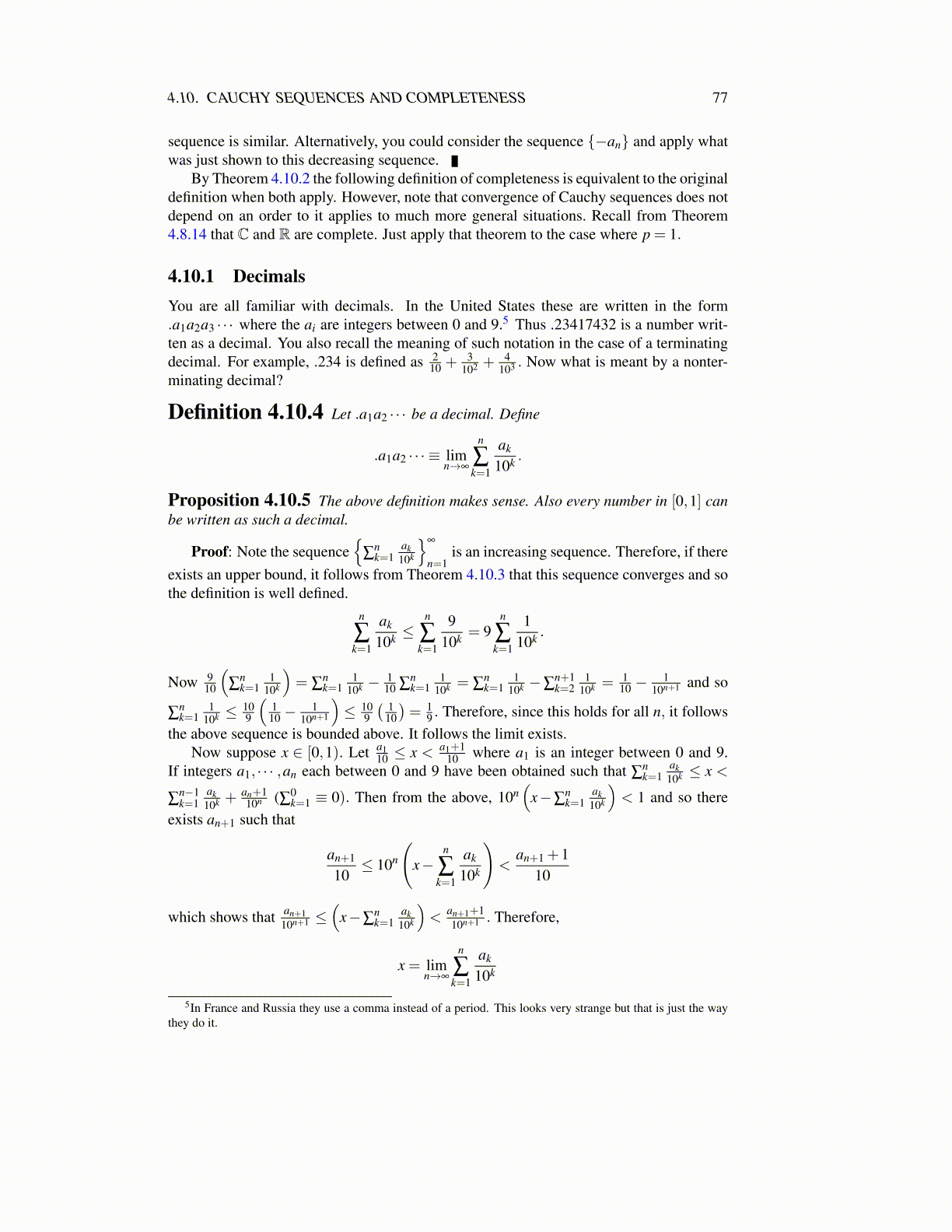
4.10. CAUCHY SEQUENCES AND COMPLETENESS 77
Definition 4.10.9 Let {an} be any sequence of points of [−∞,∞]
lim supn→∞
an ≡ limn→∞
sup{ak : k ≥ n}
lim infn→∞
an ≡ limn→∞
inf{ak : k ≥ n} .
Theorem 4.10.10 Suppose {an} is a sequence of real numbers and that
lim supn→∞
an and lim infn→∞
an
are both real numbers. Then limn→∞ an exists if and only if liminfn→∞ an = limsupn→∞ anand in this case, limn→∞ an = liminfn→∞ an = limsupn→∞ an.
Proof: First note that sup{ak : k ≥ n} ≥ inf{ak : k ≥ n} and so from Theorem 4.4.13,
lim supn→∞
an ≡ limn→∞
sup{ak : k ≥ n} ≥ limn→∞
inf{ak : k ≥ n} ≡ lim infn→∞
an.
⇒ Suppose limn→∞ an = a ∈ R. Then given ε > 0, there is N such that if n≥ N,
a− ε ≤ an ≤ a+ ε
It follows that if n≥N,a−ε ≤ Ln ≤Un ≤ a+ε.Passing to a limit, it follows from Theorem4.4.13
a− ε ≤ lim infn→∞
an ≤ lim supn→∞
an ≤ a+ ε
and so, since ε is arbitrary, liminf and limsup are equal to the limit a.⇐ Suppose liminfn→∞ an = limsupn→∞ an = a ∈ R. Then if n is large enough,
a− ε ≤ Ln ≤ an ≤Un ≤ a+ ε
Since ε is arbitrary, limn→∞ an = a.With the above theorem, here is how to define the limit of a sequence of points in
[−∞,∞], the new case being that an is allowed to be ±∞.
Definition 4.10.11 Let {an} be a sequence in [−∞,∞]. limn→∞ an exists exactlywhen liminfn→∞ an = limsupn→∞ an, and in this case
limn→∞
an ≡ lim infn→∞
an = lim supn→∞
an.
The significance of limsup and liminf, in addition to what was just discussed, is con-tained in the following theorem which follows quickly from the definition.
Theorem 4.10.12 Suppose {an} is a sequence of points of [−∞,∞]. Then let λ =limsupn→∞ an. Then if b > λ , it follows there exists N such that whenever n ≥ N,an ≤ b.If c < λ , then an > c for infinitely many values of n. Let γ = liminfn→∞ an. Then if d < γ,it follows there exists N such that whenever n ≥ N,an ≥ d. If e > γ, it follows an < e forinfinitely many values of n.
The proof of this theorem is left as an exercise for you. It follows directly from the defi-nition and it is the sort of thing you must do yourself. Here is one other simple proposition.